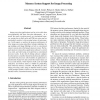Free Online Productivity Tools
i2Speak
i2Symbol
i2OCR
iTex2Img
iWeb2Print
iWeb2Shot
i2Type
iPdf2Split
iPdf2Merge
i2Bopomofo
i2Arabic
i2Style
i2Image
i2PDF
iLatex2Rtf
Sci2ools
IEEEPACT
1999
IEEE
1999
IEEE
Memory System Support for Image Processing
Image processing applications tend to access their data non-sequentially and reuse that data infrequently. As a result, they tend to perform poorly on conventional memory systems due to high cache and TLB miss rates and are particularly sensitive to the growing latency of main memory. In this paper, we analyze the memory performance of three image processing algorithms (volume rendering, image warping, and image filtering) on both a conventional memory system and on the Impulse memory system. The Impulse memory system allows application software to control how, when, and where data are loaded into a conventional processor cache. It does this by letting software configure how the memory controller interprets the physical addresses exported by the processor, which enables an application to dynamically change how data are fetched. Sparse data can be accessed densely, which improves both cache and TLB utilization, and memory latency is hidden by prefetching data within the memory controll...
Conventional Memory | Distributed And Parallel Computing | IEEEPACT 1999 | Impulse Memory | Memory System |
Related Content
| Added | 03 Aug 2010 |
| Updated | 03 Aug 2010 |
| Type | Conference |
| Year | 1999 |
| Where | IEEEPACT |
| Authors | Lixin Zhang, John B. Carter, Wilson C. Hsieh, Sally A. McKee |
Comments (0)

